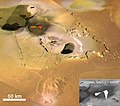File:Io Tvashtar I25.jpg
Vai alla navigazione
Vai alla ricerca

Dimensioni di questa anteprima: 679 × 600 pixel. Altre risoluzioni: 272 × 240 pixel | 544 × 480 pixel | 881 × 778 pixel.
File originale (881 × 778 pixel, dimensione del file: 85 KB, tipo MIME: image/jpeg)
Cronologia del file
Fare clic su un gruppo data/ora per vedere il file come si presentava nel momento indicato.
| Data/Ora | Miniatura | Dimensioni | Utente | Commento | |
|---|---|---|---|---|---|
| attuale | 10:44, 1 ott 2008 |  | 881 × 778 (85 KB) | Volcanopele | {{Information |Description={{en|1=NASA's Galileo spacecraft caught this volcanic eruption in action on Jupiter's moon Io on November 25, 1999. This mosaic shows Tvashtar Catena, a chain of calderas, in enhanced color. It combines low resolution (1.3 kilom |
Pagine che usano questo file
La seguente pagina usa questo file:
Utilizzo globale del file
Anche i seguenti wiki usano questo file:
- Usato nelle seguenti pagine di ca.wikipedia.org:
- Usato nelle seguenti pagine di en.wikipedia.org:
- Usato nelle seguenti pagine di en.wikiversity.org:
- Usato nelle seguenti pagine di es.wikipedia.org:
- Usato nelle seguenti pagine di fr.wikipedia.org:
- Usato nelle seguenti pagine di vi.wikipedia.org:
- Usato nelle seguenti pagine di zh.wikipedia.org:


